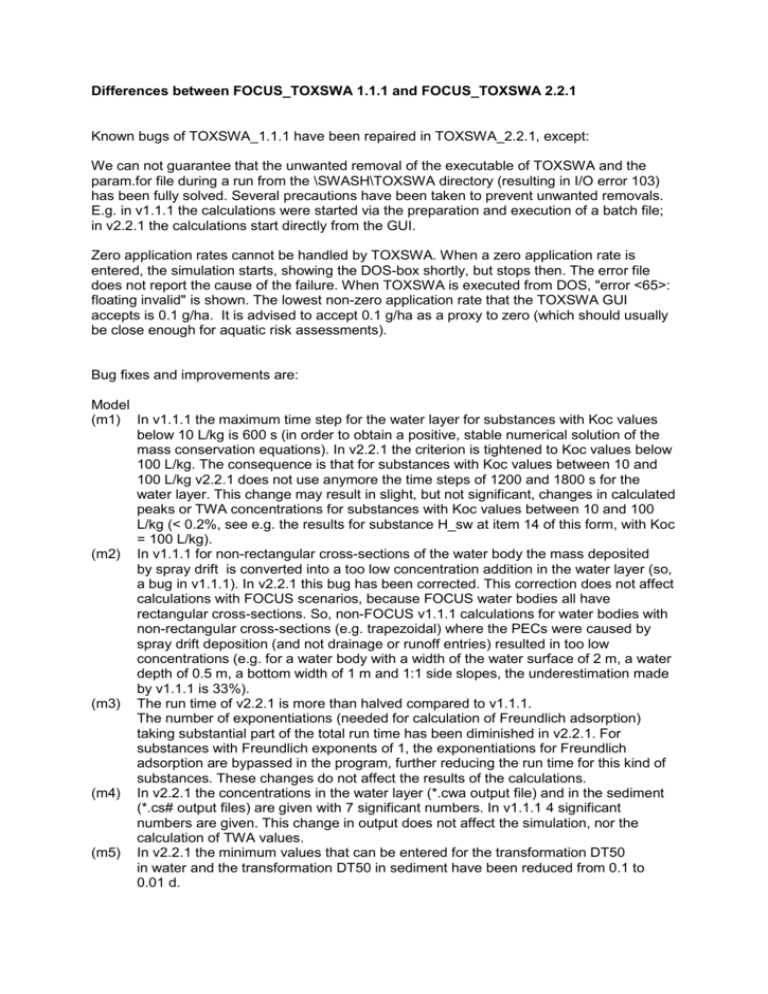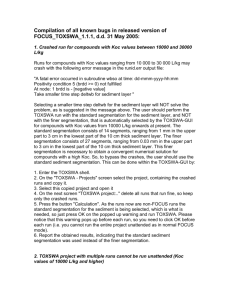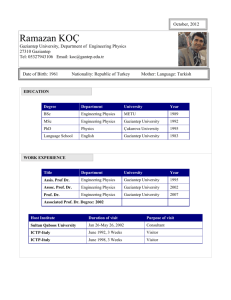Format for proposal for changing scenario input data of FOCUS
advertisement

Differences between FOCUS_TOXSWA 1.1.1 and FOCUS_TOXSWA 2.2.1 Known bugs of TOXSWA_1.1.1 have been repaired in TOXSWA_2.2.1, except: We can not guarantee that the unwanted removal of the executable of TOXSWA and the param.for file during a run from the \SWASH\TOXSWA directory (resulting in I/O error 103) has been fully solved. Several precautions have been taken to prevent unwanted removals. E.g. in v1.1.1 the calculations were started via the preparation and execution of a batch file; in v2.2.1 the calculations start directly from the GUI. Zero application rates cannot be handled by TOXSWA. When a zero application rate is entered, the simulation starts, showing the DOS-box shortly, but stops then. The error file does not report the cause of the failure. When TOXSWA is executed from DOS, "error <65>: floating invalid" is shown. The lowest non-zero application rate that the TOXSWA GUI accepts is 0.1 g/ha. It is advised to accept 0.1 g/ha as a proxy to zero (which should usually be close enough for aquatic risk assessments). Bug fixes and improvements are: Model (m1) In v1.1.1 the maximum time step for the water layer for substances with Koc values below 10 L/kg is 600 s (in order to obtain a positive, stable numerical solution of the mass conservation equations). In v2.2.1 the criterion is tightened to Koc values below 100 L/kg. The consequence is that for substances with Koc values between 10 and 100 L/kg v2.2.1 does not use anymore the time steps of 1200 and 1800 s for the water layer. This change may result in slight, but not significant, changes in calculated peaks or TWA concentrations for substances with Koc values between 10 and 100 L/kg (< 0.2%, see e.g. the results for substance H_sw at item 14 of this form, with Koc = 100 L/kg). (m2) In v1.1.1 for non-rectangular cross-sections of the water body the mass deposited by spray drift is converted into a too low concentration addition in the water layer (so, a bug in v1.1.1). In v2.2.1 this bug has been corrected. This correction does not affect calculations with FOCUS scenarios, because FOCUS water bodies all have rectangular cross-sections. So, non-FOCUS v1.1.1 calculations for water bodies with non-rectangular cross-sections (e.g. trapezoidal) where the PECs were caused by spray drift deposition (and not drainage or runoff entries) resulted in too low concentrations (e.g. for a water body with a width of the water surface of 2 m, a water depth of 0.5 m, a bottom width of 1 m and 1:1 side slopes, the underestimation made by v1.1.1 is 33%). (m3) The run time of v2.2.1 is more than halved compared to v1.1.1. The number of exponentiations (needed for calculation of Freundlich adsorption) taking substantial part of the total run time has been diminished in v2.2.1. For substances with Freundlich exponents of 1, the exponentiations for Freundlich adsorption are bypassed in the program, further reducing the run time for this kind of substances. These changes do not affect the results of the calculations. (m4) In v2.2.1 the concentrations in the water layer (*.cwa output file) and in the sediment (*.cs# output files) are given with 7 significant numbers. In v1.1.1 4 significant numbers are given. This change in output does not affect the simulation, nor the calculation of TWA values. (m5) In v2.2.1 the minimum values that can be entered for the transformation DT50 in water and the transformation DT50 in sediment have been reduced from 0.1 to 0.01 d. Model and shell (ms1) In v1.1.1 the aeric mean deposition of spray drift mass was rounded off to 0.001 mg/m2 by the GUI into the TOXSWA input file. At low application rates or low spray drift percentages (due to large buffer zones) this resulted in inexact PECs. In v2.2.1 aeric mean deposition of spray drift mass is always written in at least four significant numbers. So, the FOCUS_TOXSWA *.txw input files prepared by v2.2.1 differ from those prepared by v1.1.1, when in v1.1.1 less than four significant numbers were written in the *.txw file. This change results in different PECs in case spray drift deposition is low (e.g. due to low application rates or large buffer zones) and the PECs are caused by spray drift deposition (and not by drainage or runoff entries). The difference may maximally equal a factor 2: a mass loading of 0.0005000 mg/m2 in v2.2.1 was written as 0.001 mg/m2 in the TOXSWA input file of v1.1.1. This results in a 2 times lower concentration for v2.2.1, than the one of v1.1.1, because spray drift triggered maximum PECs are a linear function of the deposited mass on the water surface. Simulations of the D3 Ditch scenario with substance C_sw used in winter cereals with mass loadings of 0.0005000 mg/m2 and 0.001000 mg/m2 confirmed the factor 2. The different PEC is only caused by entering the four significant numbers with v2.2.1, instead of e.g. only 1 significant number. With increasing drift deposition the difference in PECs calculated with the two versions becomes smaller; with drift depositions around 0.01 mg/m2 above 1 mg/m2 the difference in calculated PECs is around 1% or less than 0.1%, respectively. (ms2) In v1.1.1 the PECs in the *.sum output file were shown down to values of 0.001 µg/L (or µg/kg D.W. for the sediment). In v2.2.1 the minimum PECs are 0.000001 µg/L (or µg/kg D.W. for the sediment). So, PEC values of zero or very small values around 0.001 µg/L (or µg/kg D.W. for the sediment) of v1.1.1 can now be refined with v2.2.1. (ms3) An option to simulate water-sediment studies is added in v2.2.1. Shell (s1) In v1.1.1 for FOCUS Step 3 runs the FOCUS_highKoc sediment segmentation (27 segments, ranging from 0.03 mm in the upper part to 3 cm in the lowest part of the 10 cm thick sediment layer) is selected automatically in runs with substance Koc values above 10 000 L/kg. In v2.2.1 the limit for automatic selection is changed from 10 000 L/kg into 30 000 L/kg. For Koc < 10 000 L/kg or Koc ≥ 30 000 L/kg this change does not result in differences in output between v1.1.1 and v2.2.1 for FOCUS scenarios. For Koc values between 10 000 L/kg and 30 000 L/kg the calculations with v2.2.1 (using the standard FOCUS sediment segmentation) may result in slightly different sediment PEC values than those obtained before with v1.1.1 (using FOCUS_highKoc sediment segmentation). If there is a difference the v1.1.1 results are closer to numerical convergence. The background of this change between v2.2.1 and v1.1.1 is that sometimes runs with substances having a Koc value between 10 000 L/kg and 30 000 L/kg crashed, because of the selected finer FOCUS_highKoc sediment segmentation (see bug 11, of updated list 2 of all known bugs for FOCUS_TOXSWA 1.1.1 at http://viso.ei.jrc.it/focus/sw/). It is the user’s responsibility to decide whether the result of v2.2.1 should be refined bey re-running with the finer sediment segmentation. (s2) In v1.1.1 the sequence of applications in runs of FOCUS step 3 projects made in SWASH are mixed up in the application scheme in the TOXSWA shell (this is a bug, see TOXSWA bug 11 of updated list 2 of all known bugs for FOCUS_TOXSWA 1.1.1 reported on http://viso.ei.jrc.it/focus/sw/ as well as the bug dated 06/Jun/05 under Download SWASH at the same website). This bug is repaired in v2.2.1 and v2.2.1 now always stops when the multiple applications of one run are not in the correct order. This bug of v1.1.1 only caused erroneous results for runs having multiple applications with different applications rates. So in those cases v2.2.1 results differ significantly from v1.1.1 results and the user is advised to check his v1.1.1 runs with multiple applications with different rates and rerun them if the sequence was mixed (s3) (s4) (s5) (s6) up. The error can be noticed by inspecting the summary output files of MACRO/PRZM (m2t/p2t files) and of TOXSWA (sum files) and can be repaired by applying the Workaround advised in the bug descriptions of SWASH and TOXSWA mentioned above. A Help function is now available. Input concerning lateral entries was located at the ‘Application schemes’ form in v1.1.1. In v2.2.1 a new tab 'Lateral entries' has been added at the Main form. In v1.1.1 the possibility to change the time step for sediment in the GUI was unintentionally locked; in v2.2.1 this time step can be changed. Graphs of calculated residues between measured concentrations and simulated concentrations can be generated. Scenario data No changes.









